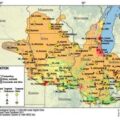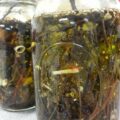[ad_1]
Runoff from pavement with coal-tar-based sealant is the primary source of toxic polycyclic aromatic hydrocarbons, or PAHs, to streambed sediments in Milwaukee, Wisconsin, according to a U.S. Geological Survey and Milwaukee Metropolitan Sewerage District study published today.
Pavement sealant is a black, shiny liquid sprayed or painted on asphalt parking lots, driveways and playgrounds to improve appearance and protect the underlying asphalt. Pavement sealants that contain coal tar, a known human carcinogen, have extremely high levels of PAHs. Some PAHs are toxic to fish and other aquatic life and several are probable human carcinogens.
Scientists with the USGS collected sediment samples from 40 streambed sites and dust samples from six parking lot sites in the Milwaukee area to determine the likely sources and toxicity of PAHs in streams. They found that dust from coal-tar-sealant contributed about 42 to 94 percent of the PAHs to the samples, with the remainder of PAHs coming from sources such as coal combustion and vehicle emissions.
Seventy-eight percent of the sediment samples collected had PAH levels that could adversely affect aquatic organisms like aquatic insects. Among the most toxic samples collected were those from sections of Lincoln Creek, Underwood Creek and the West Milwaukee Ditch.
“This study shows that PAHs pose a very real threat to aquatic organisms at the base of the food chain,” said Austin Baldwin, a USGS scientist and the lead author of the study. “In terms of toxicity to these organisms, PAHs are probably the most important contaminants in Milwaukee-area streams.”
Potential adverse effects of these PAHs on aquatic organisms include fin erosion, liver abnormalities, cataracts and immune system impairments.
“Our study did not test the human health effects of coal-tar-sealant or PAHs in the Milwaukee area,” Baldwin said. “PAHs do not easily accumulate within the food chain, so possible human-health risks associated with consumption of fish are low.”
However, Baldwin noted that previous studies have demonstrated risks associated with tracking coal-tar-sealant dust from driveways into homes. Exposure to children playing on sealed pavement could be another route.
Coal-tar sealants have significantly higher levels of PAHs and related compounds compared to asphalt-based pavement sealants and other urban sources, including vehicle emissions, used motor oil and tire particles. Stormwater runoff, wind and tires can disseminate PAH particles throughout the urban landscape.
The new USGS study is published in the journal Environmental Toxicology and Chemistry.
For more information about water-quality research in Wisconsin, please visit the USGS Wisconsin Water Science Center website. For more information about pavement sealants and PAHs, please visit the webpage about USGS research on PAHs and sealcoat.
[ad_2]
Source link
- Warmer water could cool Montana’s trout fishing economy - September 7, 2022
- Water Released from Crystallizing Magma can Trigger Earthquakes in Yellowstone - September 5, 2022
- Thermal Infrared Remote Sensing at Yellowstone 101 - August 29, 2022





